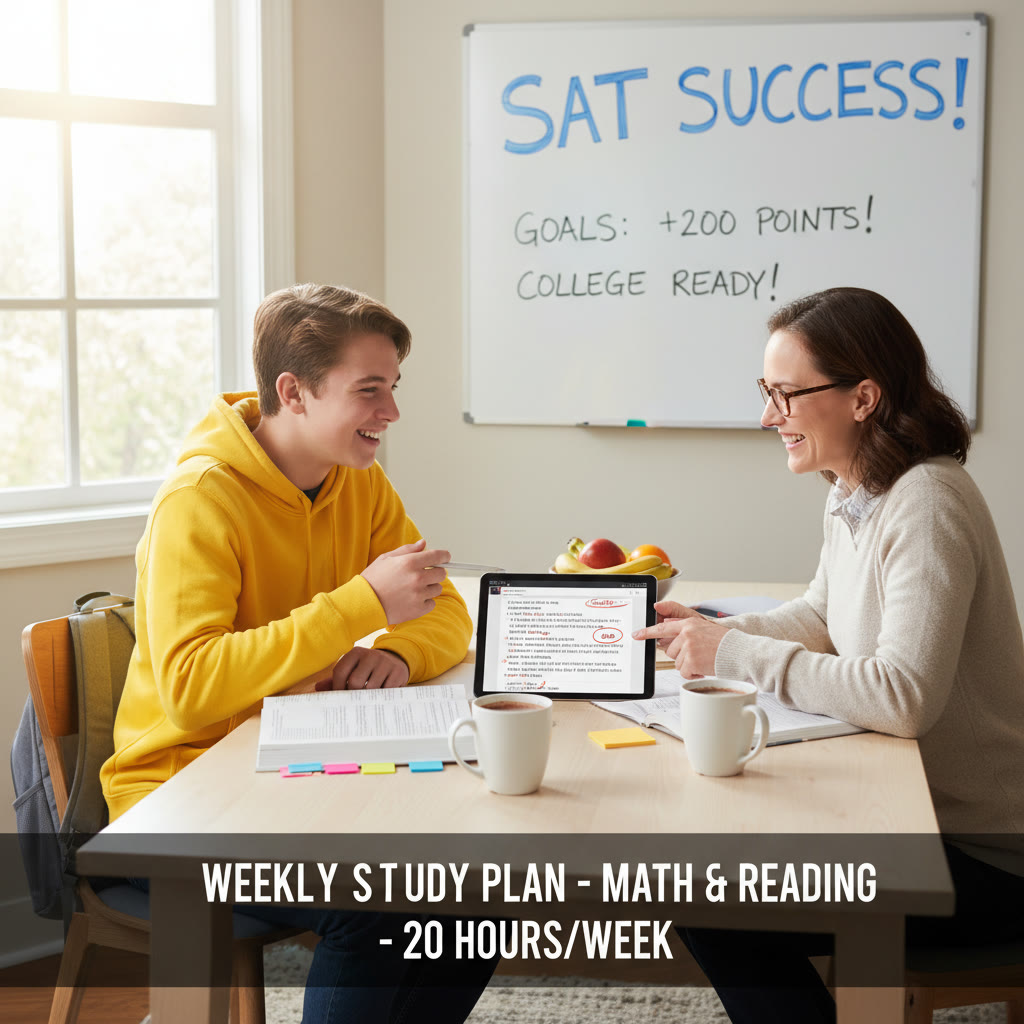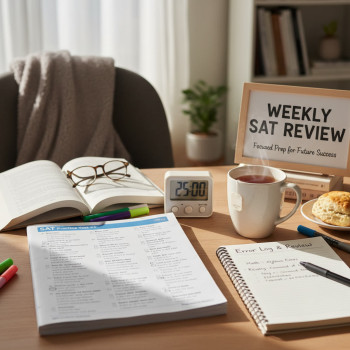Introduction: The Quiet Puzzle of Evidence-Based Reading
If you ask a dozen students what they dread most on the SAT, many will point to math or that vocabulary word that pops up in a sentence and refuses to behave. But there’s a quieter, persistent unease around the Evidence-Based Reading section. It doesn’t always feel like a test of how well you read; it feels like a test of how well you argue, infer, and resist traps—often all at once.
This post is an honest, friendly tour of why Evidence-Based Reading is so tricky and, more importantly, how to tame it. We’ll break down the common pitfalls, walk through real strategies, and offer concrete practice techniques. I’ll also highlight how one-on-one support—like Sparkl’s personalized tutoring with tailored study plans and AI-driven insights—can turn frustrating mistakes into reliable skills, when it naturally fits into your study plan.
What the Evidence-Based Reading Section Really Asks of You
The Evidence-Based Reading and Writing section tests more than your ability to absorb facts. It asks you to:
- Understand main ideas and author purpose.
- Interpret details and make safe inferences.
- Identify evidence within the passage that supports answers.
- Recognize tone, structure, and how arguments are built.
- Apply vocabulary meaning in context.
At first glance, that sounds straightforward. But the test compacts several thinking skills into short bursts of time, with tricky answer choices designed to look plausible. That’s the root of the challenge.
Seven Reasons Students Struggle (With Real Examples)
1. Passages are compact but dense
SAT passages are short compared to an essay you might read in class, yet every sentence often carries weight. Authors compress background, argument, nuance, and counterpoint into a few paragraphs. Students who skim lightly pick up keywords but miss connective reasoning that answers many questions.
2. Questions require evidence, not opinion
Many questions will ask you to choose the answer best supported by the passage. That means even if an answer feels true based on your knowledge, it’s wrong if the passage doesn’t support it. Imagine the passage says a new policy reduced commutes for some workers; it doesn’t mean everyone benefits. Tests reward precise reading, not general knowledge.
3. The pair-question trap
Some questions come in pairs: first, select the correct answer to a main question; next, choose the line or lines that best support your previous choice. Students hurry through the first and answer the second by memory. When the evidence is specific, memory can mislead you. The safest route is to go back and match carefully.
4. Tone and implication are sneaky
Distinguishing between what an author says and what they imply takes practice. Is the tone ironic or admiring? Is the author skeptical or open-minded? The right answer will often hinge on tone, which is suggested by word choice and sentence structure.
5. Vocabulary questions punish guesses
On the SAT, vocabulary questions usually ask for the meaning in context. A rare familiar word might have five meanings, only one of which fits the sentence. Choosing the most common meaning rather than the context-specific meaning is a frequent mistake.
6. Time pressure makes careful reading harder
One passage, followed by several questions, all under a strict time limit—this structure rewards efficient strategies. Students who read every sentence with equal attention waste time; those who skim too much miss crucial details. Finding the balance takes guided practice.
7. Answer choices are intentionally tempting
Wrong answers often look right. They may restate a line in the passage out of context, take a subtle claim too far, or introduce an idea the author rejects. Learning to spot subtle distortions is part training and part pattern recognition.
How to Think Like the Test-Maker (Not Like a Reader)
The SAT designs choices to separate careful readers from casual ones. Thinking like the test-maker means realizing each wrong answer is not random; it’s crafted to appeal to a specific misreading. When you practice, try to label why each incorrect answer tempts you: Is it a paraphrase that ignores context? Is it an inference that goes beyond the passage? Naming the trap helps you avoid it next time.
Practical Strategies That Work
Active reading over passive skimming
Active reading is short, strategic, and purposeful. It doesn’t mean underlining every word. Try this minimalist approach:
- Read the first and last paragraphs and the topic sentences of the middle paragraphs to find the main idea.
- Underline or circle transition words: however, moreover, therefore, yet. They reveal structure.
- When you meet a question that asks for evidence, go back and re-read the specific lines before answering.
Answer-first, evidence-second for some question types
For single-line detail questions, it can be efficient to read the question first, then find the line. For main idea or tone questions, read the passage first. Tailor the approach to the question type and your own strengths.
Use the process of elimination deliberately
Instead of trying to identify the exact right answer in one go, eliminate options that are clearly wrong. This is especially helpful when answer choices are closely worded. If you can narrow to two, compare them against the passage language and look for wording that overreaches.
Translate vocabulary in context
When a vocabulary question asks for a word’s meaning, plug each answer choice back into the sentence. The one that makes the sentence logical and consistent with tone is usually correct. If two fit, pick the one that aligns better with the rest of the passage.
Practice paired-evidence questions as pairs
When a question pair asks for an answer and then the lines that support it, treat them as a unit. Select the answer, then before looking at the evidence choices, go to the passage and find the lines that convince you. This prevents relying on memory or faulty assumptions.
Simulate test conditions, but analyze mistakes deeply
Timed practice is essential, but the gold is in review. After each timed set, spend more time analyzing wrong answers than you did answering them. Ask: Was my error careless, conceptual, or strategic? That reflection drives improvement faster than volume alone.
Side-by-Side: Common Pitfalls and Fixes
| Pitfall | Why it Happens | Fix |
|---|---|---|
| Choosing an answer that “sounds right” | Relying on background knowledge rather than passage support | Force yourself to cite the exact line(s) that support the answer |
| Misreading the author’s tone | Missing subtle cues in diction and phrasing | Mark emotionally loaded words and contrastive phrases |
| Falling for close paraphrases | Choosing an answer that rewords a line without considering context | Ask whether the choice changes meaning when placed next to neighboring sentences |
| Rushing through paired evidence questions | Time pressure and overconfidence | Always find the evidence in the passage before choosing it |
A Worked Example: From Confusing to Clear
Imagine a short passage about a city renovating an old waterfront mill into a public market. The author notes local businesses worry about rent increases but argues the market can boost small vendors by increasing foot traffic.
Sample question
Which choice best describes the author’s attitude toward the renovation?
- A. Unqualified enthusiasm
- B. Skeptical and dismissive
- C. Cautiously optimistic
- D. Indifferent
At first, a student might choose A because the author highlights benefits. But read carefully: the author also lists concerns and frames benefits as conditional. The best answer is C, cautiously optimistic, because it captures both support and reservation.
Paired evidence
Now the paired question asks which lines support the previous answer. Suppose the lines that balance both concerns and support appear in paragraphs 2 and 4. The correct evidence will show both the worries of local businesses and the market’s conditional benefits. If one evidence choice only presents the benefits without acknowledging concerns, it’s incomplete and therefore incorrect.
How to Build These Skills Week by Week
Progress usually comes in steady increments. Below is a simple four-week scaffold you can adapt. Be honest about your starting level and adjust pacing accordingly.
| Week | Focus | Practice |
|---|---|---|
| 1 | Understanding passages and main ideas | Daily short passages, focus on topic sentences and tone |
| 2 | Evidence pairing and detail questions | Paired questions practice, always find evidence in passage |
| 3 | Vocabulary in context and inference | Targeted vocab drills in passages, inference practice |
| 4 | Timed sets and error analysis | Two timed sections per week, deep review of mistakes |
How Personalized Help Accelerates Progress
Some students make huge leaps simply by being guided to the right practice. Personalized tutoring helps because it targets your specific error patterns—whether that’s misreading tone, mishandling paired evidence, or losing time to careful re-reading. Sparkl’s personalized tutoring, for instance, offers 1-on-1 guidance, tailored study plans, expert tutors, and AI-driven insights that identify recurring mistakes and recommend focused drills. That kind of targeted attention makes practice more efficient and less frustrating.
Study Tools and Habits That Make a Difference
1. Keep a mistake log
Every time you miss a question, write down the question type, why you missed it, and what you’ll do differently next time. After a month, patterns emerge—then you can attack those weaknesses directly.
2. Read widely and thoughtfully
Read opinion pieces, short science articles, or historical essays. Look for argument structure, evidence, and tone. This low-stakes reading builds a sense for how writers construct claims and support them.
3. Practice under simulated conditions
When it’s time to simulate, match the official timing and environment. But treat practice mistakes as study fodder, not failures. Analyze each wrong answer until you can explain precisely why it was wrong and why the right answer wins.
4. Talk through tricky passages
Explaining your reasoning aloud or to a tutor forces clarity. You’ll catch assumptions you hadn’t noticed and develop vocabulary to describe your thought process.
Quick Checklist to Use During the Test
- Read the question before the passage for detail questions; otherwise read passage first.
- Underline or circle key transition words when you read.
- For evidence questions, go directly to the passage lines before choosing.
- Eliminate obviously wrong answers first.
- If stuck, mark and return—don’t let one question steal time from others.
When to Consider Tutoring
If you’ve been practicing on your own for several weeks and your scores plateau, a few sessions of personalized tutoring can help you break through. Effective tutors don’t just tell you the right answers; they reveal patterns in your mistakes and coach strategies until they become habits. Sparkl’s tailored study plans and expert tutors can be particularly helpful for students who need a roadmap and someone to hold them accountable, combined with AI-driven insights to track progress.

Final Thoughts: It’s Tricky, But It’s Tameable
The Evidence-Based Reading section rewards precision, not speed alone. By shifting habits from passive reading to active, evidence-focused thinking, you’ll convert vague instincts into reliable answers. Take advantage of deliberate practice, keep a disciplined review routine, and consider targeted help when your progress stalls. With focused work and the right strategies, that uneasy feeling about evidence-based questions will fade—and confidence will take its place.
Remember: reading better for the SAT also makes you a stronger thinker. These skills pay off in class, essays, and the kinds of reasoning you’ll use for years. If you want a structured plan and human coaching to speed your progress, tools like Sparkl’s personalized tutoring provide tailored study plans, 1-on-1 guidance, and AI-driven insights to help you improve faster and with less frustration.

Actionable Next Steps
Start today with one small routine: do two short passages under timed conditions, log mistakes, and review each wrong answer for five minutes. Repeat this three times a week and add one session with a coach or tutor every two weeks to correct course. Small, consistent steps beat cramming every time.
Encouragement to Keep Going
Evidence-Based Reading is tricky because it asks you to be both precise and flexible: precise in matching answers to the passage, and flexible in reading different authors and styles. That combination is teachable. Stay curious, keep analyzing your errors, and don’t be afraid to ask for help. The next time a paired evidence question appears, you’ll find the lines that support your answer—and feel a little smarter for it.
















No Comments
Leave a comment Cancel